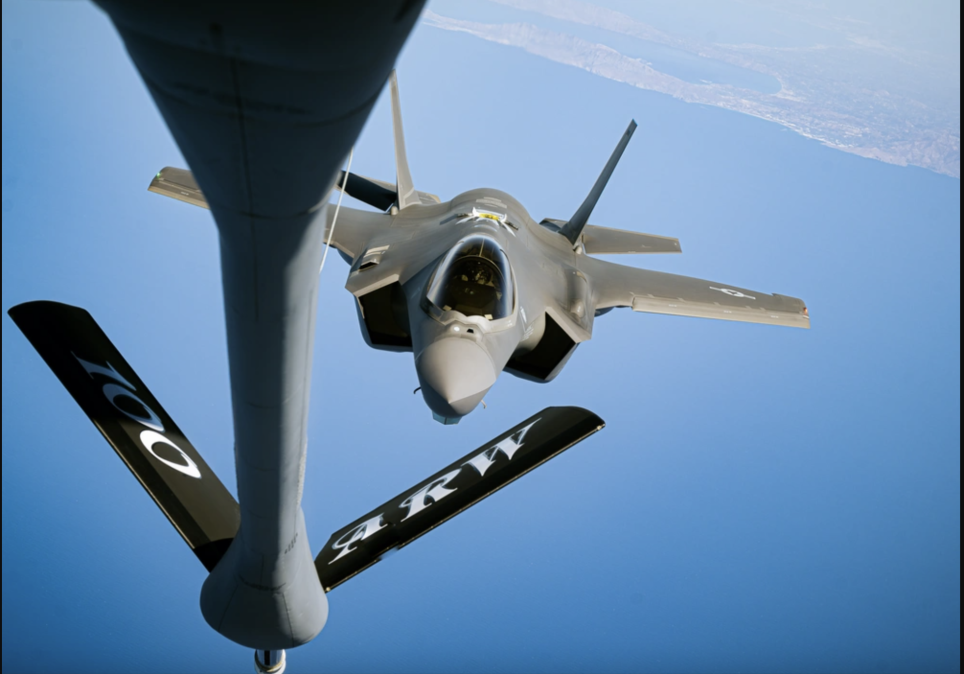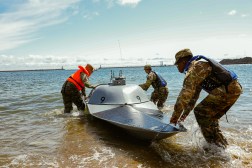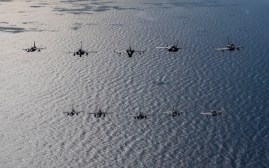Army, Air Force embark on multi-national exercises to counter emerging threats to NATO

Against a backdrop where military personnel are operating at the nexus of multiple complex threats, command leaders for Army and Air Force units across Europe and Africa are facilitating new and creative joint exercises to push modernization and transformation alongside some of America’s closest military partners.
The recently completed Ramstein Flag 2024 and the ongoing and more secretive Neptune Eagle, among a variety of other related exercises and activities, are paving new means to combat anti-access/area-denial (A2/AD) capabilities that could affect who can enter critical real-world operating environments. They’re also enabling deeper interoperability, according to service members steering and participating in these future-focused events.
On Wednesday, a defense official who spoke to DefenseScoop on the condition of anonymity said that participation in such counter-A2/AD exercises ensures that “NATO can gain air superiority in future contested scenarios, alongside allies and partners.”
“That’s what it’s all designed to do,” the official said.
For instance, they pointed to the first-ever Ramstein Flag exercise, which unfolded in Greece earlier this month. Upwards of 130 military aircraft from 12 nations flew in the large-scale training and capability showcase.
Roots of Ramstein Flag trace back to a first-ever NATO weapons and tactics forum that Gen. James Hecker, who leads U.S. Air Forces in Europe-Air Forces Africa and Allied Air Command, hosted a year-and-a-half ago. A major aim was to develop new and timely concepts and approaches with tactical experts from across the alliance.
“We do this on the U.S. side of the house all the time. But [Hecker] did this for the first time with NATO allies. And then that kind of drove smaller exercises — command post exercises and part task training with smaller groups, which evolved into a larger Ramstein Flag 2024 live-flying exercise with more than 100 NATO aircraft operating from eleven different locations,” the official told DefenseScoop.
Those involved are planning for the next Ramstein Flag iteration to take place in the Netherlands sometime around spring 2025.
During a virtual media roundtable held on the sidelines of the annual AUSA conference last week, senior Army officials leading the force’s hubs across Europe and Africa spotlighted different exercises and events their teams engaged in so far this year that are broadly helping NATO rapidly experiment and modernize for the “future fight.” Notably, the events are informed by real-world warfare between Russia and Ukraine, and elsewhere.
The Army’s 2nd Cavalry Regiment is the “rapid response force that’s nested and partnered with NATO, allies and partners across the European theater,” Command Sgt. Maj. Dennis Doyle told reporters — therefore operating “with the enemy at the doorstep.”
He spotlighted how the unit is adopting new “mission partner kits.”
“It’s like the big talking point for us on the NATO alliance, because what this has done is a piece of equipment that allows our partners and allies to quickly integrate en route to any conflict,” Doyle explained.
The kits enable users to transmit voice communication that he said is secure with translation capabilities. Among other features, the tools also help the international militaries tapping into them synchronize on-the-ground efforts and share a bird’s eye view of the battlefield.
“And, we can all do that en route. An example of that just recently,” Doyle said, “is Saber Strike from back in April.”
That multilateral NATO exercise spanned nearly that entire month and concentrated a bit on enabling distributed command and control between the countries involved.
“[We] conducted one of the largest tactical road marches in Europe since World War II,” Doyle told reporters.
With the mission partner kits, he added, the team was able to successfully expand the NATO battle group to a brigade-size element for the second time in a row. They were also able to “synchronize live-fire operations while executing command and control over three areas — from Lithuania, the Suwałki Gap with the Territorial Defense Forces, and then [the Bemowo Piskie Training Area in Poland] — all simultaneous on the same timeframe, while under one command,” according to Doyle.
“And what that did at the end of the day, it gave us the capacity to demonstrate to our partners and allies that [U.S. Army Europe and Africa, or USAREUR-AF], V Corps and the NATO alliance are primed and ready to fight now and win as a joint force against anything if we’re called to action,” he added.
During the media roundtable, commanding general of the Army’s V Corps Lt. Gen. Charles Costanza and commanding general of 56th Artillery Command Maj. Gen. John Rafferty additionally pointed to the Avenger Triad 24 exercise that was held for two weeks in September.
The event — led by USAREUR-AF — connected thousands of military personnel from more than 10 participating nations, including some that border Russia.
“Avenger Triad was an opportunity for us — really, for the first time — to take these effects from different domains and converge them against multiple sets of targets. Our mission during that was kind of multifaceted. In one case, part of the reason for our existence is because of the anti-access/area-denial threat that exists in Europe. So, that’s a big responsibility for us is to open up windows of opportunity for the joint force,” Rafferty said.
He also referenced the recent U.S.-led Arcane Thunder exercise that was designed to demonstrate theater-wide synchronization and multi-domain operations in Germany and Morocco.
“The Moroccans are great partners. They’re so easy to train with, and important and valuable partners in the region, but also provided a really unique and permissive training environment that allowed us to really get after some deep-sensing experimentation from high-altitude sensors, and then really work … on our targeting and long-haul comms,” Rafferty told reporters.
He noted that his command’s “training continues.” Without naming it, Rafferty mentioned an in-progress exercise the Army is conducting with the Air Force, which he said is “focused primarily on A2/AD.”
In response to multiple inquiries from DefenseScoop, Army spokespersons confirmed that Rafferty was referring to the Neptune Eagle exercise, but they declined to provide any more information.
Besides that it seeks to advance kill-chains and battle management tasks and is planned for Oct. 16-24, the majority of details about Neptune Eagle are classified or protected from wide dissemination for what the Pentagon considers security purposes.
In a statement on Wednesday, a spokesperson from U.S. Air Forces in Europe and Africa told DefenseScoop: “The Neptune series of events are joint air interoperability exercises designed to maintain readiness and evaluate employment capabilities in a realistic training environment. The exercises consist of U.S. personnel from across the services.”






